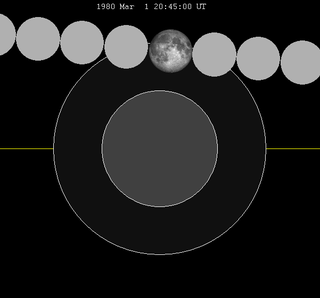March 1979 lunar eclipse — A partial lunar eclipse took place on March 13, 1979. This event followed the total solar eclipse of February 26, 1979. Contents 1 … Wikipedia
March 1978 lunar eclipse — The moon passed through the center of the Earth s shadow A total lunar eclipse took place on March 24, 1978. The moon passed through the center of the Earth s shadow. [1] Contents … Wikipedia
March 2006 lunar eclipse — Penumbral lunar eclipse March 14, 2006 0:54 UT from Warrenton, Virginia (Penumbral shadow visible faintly on the right an hour past greatest eclipse) … Wikipedia
March 1988 lunar eclipse — The entire moon passed through the penumbral shadow during this eclipse. It grazed the northern edge of the Earth s umbral shadow, but not sufficiently to qualify a partial eclipse. The partial eclipse lasted just 14 minutes the shortest until… … Wikipedia
Crucifixion darkness and eclipse — A solar eclipse from August 2008. It takes about an hour for the moon to cover the sun, with total coverage lasting a few minutes.[1] … Wikipedia
Colonization of the Moon — Lunar outpost redirects here. For NASA s plan to construct an outpost between 2012 and 2024, see Lunar outpost (NASA). Moonbase redirects here. For other uses, see Moonbase (disambiguation). 1986 artist concept The colonization of the Moon is the … Wikipedia
Hipparchus — (Greek polytonic|Ἵππαρχος; ca. 190 BC ndash; ca. 120 BC) was a Greek astronomer, geographer, and mathematician of the Hellenistic period.Hipparchus was born in Nicaea (now Iznik, Turkey), and probably died on the island of Rhodes. He is known to… … Wikipedia
Month — For the Egyptian hawk god, see Monthu. A month is a unit of time, used with calendars, which was first used and invented in Mesopotamia, as a natural period related to the motion of the Moon; month and Moon are cognates. The traditional concept… … Wikipedia
china — /chuy neuh/, n. 1. a translucent ceramic material, biscuit fired at a high temperature, its glaze fired at a low temperature. 2. any porcelain ware. 3. plates, cups, saucers, etc., collectively. 4. figurines made of porcelain or ceramic material … Universalium
China — /chuy neuh/, n. 1. People s Republic of, a country in E Asia. 1,221,591,778; 3,691,502 sq. mi. (9,560,990 sq. km). Cap.: Beijing. 2. Republic of. Also called Nationalist China. a republic consisting mainly of the island of Taiwan off the SE coast … Universalium


















